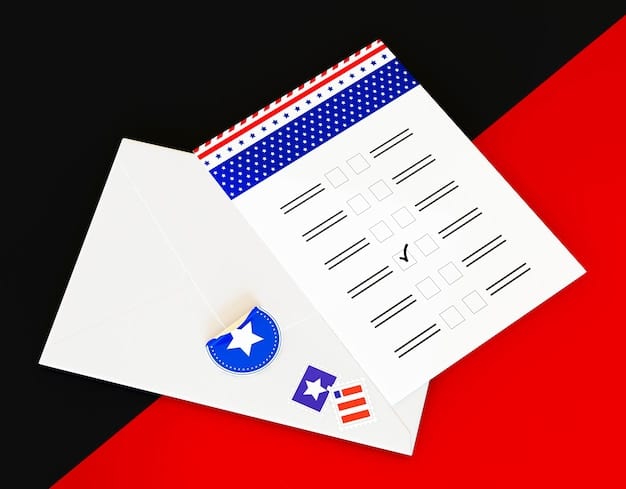Public Charge Rule 2025: Impact on Mexican Immigration Cases

The proposed changes to the Public Charge rule in 2025 could significantly alter how Mexican immigrants demonstrate self-sufficiency, potentially impacting various U.S. immigration applications, including visas, green cards, and status adjustments, by broadening the scope of public benefits considered.
Understanding How the Proposed Changes to Public Charge Rule in 2025 Could Affect Your Mexican Immigration Case is crucial for anyone navigating the complex landscape of U.S. immigration. This evolving policy carries significant implications, potentially altering the path to permanent residency and other immigration benefits for Mexican nationals.
Decoding the Public Charge Rule: Historical Context and Evolution
The concept of “public charge” is rooted deeply in U.S. immigration law, designed to prevent individuals who are likely to become primarily dependent on government assistance from gaining admission or permanent residency. Historically, this rule has been a point of contention, fluctuating in interpretation and enforcement across different administrations. Its essence, however, remains to ensure immigrants can be self-sufficient and contribute to society.
The original framework, largely undisturbed for decades, primarily focused on cash assistance for income maintenance and long-term institutionalization at government expense. This narrow interpretation provided a relatively clear guideline for adjudicating immigration cases. Applicants typically needed to demonstrate sufficient financial resources or have a sponsor who could provide an Affidavit of Support, ensuring they wouldn’t overly burden public resources.
Key Historical Interpretations of Public Charge
Over time, various administrations have attempted to clarify or expand the rule’s scope, often leading to confusion and legal challenges. The 1996 welfare reform laws, for instance, significantly limited immigrant access to public benefits, inadvertently making the public charge test more stringent in practice, as many immigrants feared utilizing any assistance program.
- Early 20th Century: Focused on visible signs of poverty or mental instability.
- Mid-Late 20th Century: Emphasized cash assistance and long-term care.
- Post-1996 Welfare Reform: Reinforced the self-sufficiency principle, but interpretations remained largely consistent with cash-based benefits.
The most recent significant change prior to the proposed 2025 adjustments came with the 2019 “Public Charge Rule,” which dramatically expanded the types of benefits considered, including non-cash benefits like Medicaid, SNAP, and housing assistance. This rule sparked immense controversy, leading to numerous lawsuits and a chilling effect on immigrant communities who became hesitant to access vital services out of fear of jeopardizing their immigration status. Though largely rescinded in 2021, its brief existence highlighted the potential for broad interpretation and the significant impact on immigrant families. Understanding this historical context is vital when assessing the proposed 2025 changes, as they represent the latest iteration in a long-standing debate over immigrant self-sufficiency.
The proposed 2025 changes aim to refine the current regulations. They seek to balance the government’s interest in self-sufficiency with humanitarian concerns and the equitable treatment of immigrants. The goal is to provide clearer guidelines, though the nuances of these changes are what will ultimately dictate their real-world impact on Mexican immigration cases. The shift intends to address perceived ambiguities that existed in previous versions of the rule, offering a more streamlined, yet potentially more rigorous, assessment framework.
Overview of the Proposed 2025 Public Charge Rule Changes
The proposed changes to the Public Charge Rule for 2025 represent a significant policy refinement, moving beyond the immediate aftermath of the 2019 rule and aiming for a more stable, yet potentially more encompassing, framework. While specific details are still emerging and subject to public comment periods and finalization, the general direction points towards a subtle expansion in the criteria assessed, coupled with an emphasis on a “totality of circumstances” review.
One of the primary objectives of these adjustments is to codify certain aspects of the public charge determination process that have previously been subject to varying interpretations. This legislative effort seeks to provide more consistent guidance for both immigration officers and applicants, theoretically reducing ambiguity. However, the practical implications for applicants might involve a more thorough review of their financial history and their prospective ability to support themselves without public assistance.
Key Proposed Adjustments and Their Scope
Among the most discussed aspects of the 2025 proposals is the potential for a broadened consideration of an applicant’s “rehabilitation” or steps taken to become self-sufficient after receiving public benefits. This could mean increased scrutiny for past benefit usage, even if minimal, and a greater emphasis on demonstrating a clear path towards financial independence. The focus will not solely be on benefits received, but also on the individual’s efforts to mitigate the need for such aid.
- Definition of Public Benefits: While the 2019 rule’s exhaustive list of non-cash benefits is unlikely to return in its entirety, there may be a nuanced expansion of what constitutes primary dependence. This could include certain long-term or significant non-cash benefits that directly substitute for income.
- Factors Considered: The “totality of circumstances” remains central, encompassing age, health, family status, assets, resources, financial status, education, and skills. The new proposals might introduce specific weighting or considerations for these factors. For instance, a stronger emphasis might be placed on sustainable employment history and health insurance coverage.
- Prospective vs. Past Use: The rule is fundamentally prospective, assessing the likelihood of becoming a public charge in the future. However, past usage of benefits can be an indicator. The 2025 changes might refine how past use is weighed, potentially making it a more impactful factor if not adequately explained or mitigated.
Furthermore, the proposed changes might introduce specifics regarding who is exempt from the public charge rule, aiming to provide clearer carve-outs for specific vulnerable populations, such as refugees, asylees, and victims of human trafficking. The intent is to streamline the process for those genuinely needing protection while maintaining vigilance for others. This attempt to formalize exemptions could reduce administrative burdens for certain categories of applicants.

These proposals are currently in a period of public review, allowing stakeholders to voice concerns and suggest modifications. The final rule will reflect these considerations, but the general trajectory indicates a continued emphasis on demonstrating financial stability and self-sufficiency for all immigration applicants. The implications for Mexican immigrants, in particular, who often utilize family reunification pathways, could be substantial, requiring a meticulous review of their financial preparedness and support networks.
Direct Impact on Mexican Immigration Cases: Visa and Green Card Applications
The proposed 2025 Public Charge Rule changes bear significant implications for Mexican nationals pursuing U.S. immigration, particularly those applying for visas or green cards. The direct effects will largely revolve around a heightened scrutiny of an applicant’s financial independence and the robust demonstration of sponsorship, altering the dynamics of case adjudication.
For visa applicants, especially those seeking family-sponsored visas, the burden of proof regarding self-sufficiency could increase. Consular officers abroad, already tasked with assessing a broad range of factors, might be more inclined to scrutinize an applicant’s past economic history and future prospects in the U.S. This could translate into more requests for evidence, prolonged processing times, and a higher rate of initial denials if documentation is deemed insufficient. The aim is to ensure applicants do not become reliant on government aid, emphasizing their ability to stand on their own feet or have robust family support.
Increased Scrutiny for Affidavit of Support (Form I-864)
The Affidavit of Support (Form I-864) submitted by U.S. citizen or lawful permanent resident sponsors for their immigrant relatives will likely face rigorous examination. While the income thresholds for sponsors might not drastically change, the emphasis on the sponsor’s ability to maintain that income over the long term, and their history of supporting past immigrants, could become a more prominent consideration. This means sponsors may need to provide more comprehensive financial documentation, including tax returns spanning several years, employment verification, and asset statements.
Moreover, the proposed rule could prompt consular officers to delve deeper into the nature of the relationship between the sponsor and the applicant, ensuring the commitment to support is genuine and sustainable. Any indication of potential future financial strain on either party could result in enhanced questioning or the need for a co-sponsor, adding complexity and time to the application process.
- Visa Interviews: Applicants may face more detailed questions regarding their financial plans, job skills, and any past use of benefits in Mexico or the U.S. The onus will be on the applicant to clearly articulate their path to self-sufficiency.
- Documentation Requirements: Expect demands for more extensive financial records, bank statements, property ownership, and evidence of stable employment or business ventures in Mexico. Even seemingly minor inconsistencies could trigger requests for additional information.
- Sponsor Eligibility: The proposed changes might include refined criteria for sponsor eligibility, focusing on long-term financial stability and a clean record of fulfilling past sponsorship obligations. This could lead to a preference for sponsors with robust and diversified income sources.
For green card applicants, especially those adjusting status from within the U.S., the impact is similar but localized. U.S. Citizenship and Immigration Services (USCIS) adjudicators will apply the new guidelines during the interview process, specifically assessing the applicant’s likelihood of becoming a public charge. This includes a review of any public benefits received while in the U.S., even if inadvertently. The rule is not punitive for past benefits unless they indicate a future likelihood of dependence but understanding the nuances is critical.
It’s important to note that the proposed changes are fundamentally about prospective dependence. However, past actions, such as relying on certain public benefits, will serve as indicators. For Mexican nationals, who might have economic ties and familial obligations that transcend borders, demonstrating a clear path to financial independence in the U.S. will be paramount. This could involve showing access to stable job opportunities, private health insurance, and a robust support network, reinforcing the idea that they will not rely on U.S. taxpayer-funded programs.
Mitigation Strategies for Mexican Applicants Under the New Rule
Navigating the proposed Public Charge Rule changes requires a proactive and strategic approach, especially for Mexican applicants. Mitigation strategies should focus on demonstrating financial self-sufficiency and robust support networks, thereby alleviating concerns about future reliance on public benefits. Preparing comprehensive documentation and understanding the nuances of the rule are paramount.
One of the most effective strategies involves meticulous financial planning and documentation. Applicants should aim to compile a detailed record of their income, assets, and liabilities. This includes consistent employment history, bank statements showing stable savings, property ownership, and any investments. The goal is to paint a clear picture of an individual or family robustly capable of supporting themselves without recourse to public funds. Early preparation of these documents can significantly streamline the application process and reduce the likelihood of delays or requests for further evidence.
Strengthening the Affidavit of Support and Financial Evidence
For family-sponsored cases, which are common among Mexican immigrants, emphasizing the strength of the Affidavit of Support (Form I-864) is critical. Sponsors need to demonstrate that their income substantially exceeds the federal poverty guidelines and that they have the financial capacity to support the applicant. This might involve proactively providing more than the minimum required documentation, such as several years of tax returns, detailed pay stubs, and evidence of substantial assets like real estate or retirement accounts. If the primary sponsor’s income is borderline, a joint sponsor should be considered early in the process to bolster the application.
- Proactive Financial Planning: Save consistently, reduce debt, and build a strong credit history to demonstrate financial responsibility.
- Health Insurance: Obtain private health insurance if possible, as access to healthcare is a significant factor in public charge assessments. This showcases a plan to cover potential medical expenses without relying on public programs like Medicaid.
- Education and Skills: Document all educational qualifications, vocational training, and professional skills that will enhance employability in the U.S. Highlighting transferable skills pertinent to the U.S. job market can also be beneficial.
- Legal Counsel: Engage with an experienced immigration attorney specializing in public charge cases. They can provide tailored advice, review documentation, and prepare applicants for potential challenges during interviews.
Furthermore, applicants should be prepared to discuss their job prospects in the U.S. If they have specific job offers, professional licenses, or demonstrate a high demand for their skills, this can significantly strengthen their case. Even for those without a pre-arranged job, articulating a realistic plan for employment search and outlining potential career paths can be beneficial. It’s about showcasing a forward-looking strategy for self-sufficiency rather than solely relying on past financial standing.

Finally, understanding what benefits are NOT considered for public charge determinations is equally important. Many benefits, such as emergency medical care, disaster relief, school lunches, and certain housing assistance for specific vulnerable populations, are exempt. Knowing these distinctions can help alleviate unnecessary fears and ensure applicants do not forego essential services out of misunderstanding. The key is to be informed, prepared, and transparent in demonstrating a genuine commitment to self-sufficiency.
Case Studies and Examples: Learning from Past Public Charge Applications
Examining past public charge applications, particularly those involving Mexican nationals, offers invaluable insights into the practical application of the rule and the strategies that have proven successful or problematic. While the 2025 changes introduce new nuances, the core principles of demonstrating self-sufficiency remain. These case studies highlight the importance of thorough documentation, credible sponsorship, and a clear articulation of future plans.
One notable example involves a Mexican family where the principal applicant sought a green card through a U.S. citizen spouse. During the 2019 public charge rule’s brief implementation, their application faced significant hurdles due to the spouse’s fluctuating income and a brief period where the applicant had inadvertently accessed Medicaid for emergency care. The case was initially stalled because of concerns about the sponsor’s financial stability and the applicant’s past benefit use. It was only after securing a joint sponsor with a strong financial standing and providing detailed explanations and evidence for the emergency Medicaid use (clarifying it was not for long-term care) that the case moved forward. This emphasizes the need for strong, consistent financial backing and clear communication regarding any past use of benefits.
Lessons from Challenging Cases
Another case involved a young Mexican professional applying for an employment-based green card. Despite having a strong job offer with a high salary, the applicant faced scrutiny because of a brief gap in employment history and relatively low savings. The USCIS adjudicator questioned their ability to maintain self-sufficiency during potential future unemployment periods. The applicant successfully countered this by providing documented evidence of severance pay, unemployment benefits received during the gap (which are not considered for public charge), and a detailed plan for managing finances during any future transitions, including plans for private health insurance. This illustrates that good intentions must be backed by a clear financial foresight and documentation.
- Sponsor’s Income Consistency: Cases where sponsors demonstrated stable income over several years, well above the poverty line, tended to fare better. Fluctuations or reliance solely on current income proved challenging.
- Documentation Depth: Applications with comprehensive financial documents, including multiple years of tax returns, bank statements, and asset declarations, were processed more smoothly. Vagueness or missing information almost always led to requests for evidence.
- Health Considerations: Applicants presenting pre-existing conditions without clear plans for private healthcare coverage or adequate funds for medical expenses faced greater scrutiny. Demonstrating private health insurance or sufficient financial resources for potential medical needs was crucial.
Conversely, cases that struggled often lacked sufficient financial documentation from either the applicant or the sponsor. For instance, some Mexican applicants who had extended stays in the U.S. on non-immigrant visas and used certain public benefits without understanding the implications found their adjustment of status applications delayed. These delays often arose because their past benefit use, when combined with less robust financial evidence, triggered public charge concerns. These examples underscore the critical need for comprehensive preparation and, if necessary, the involvement of an experienced immigration attorney who can anticipate and address potential red flags.
The core lesson from these cases, applicable to the 2025 rule, is that a clear and compelling narrative of self-sufficiency matters as much as the raw numbers. Applicants and their sponsors must not only meet the financial thresholds but also be prepared to demonstrate a sustained ability to support themselves and their families, even in unforeseen circumstances. This holistic approach, considering all factors, is what defines a strong public charge argument.
Long-Term Implications for Mexican Communities in the U.S.
The proposed 2025 Public Charge Rule changes carry profound long-term implications for Mexican communities living in the U.S., extending beyond individual immigration cases. These policy shifts can influence community dynamics, access to essential services, and even cross-border relations. Historically, immigration policy changes have often disproportionately affected Mexican nationals due to their large numbers and established migratory patterns.
One significant long-term effect could be a chilling effect on the utilization of public benefits. Despite clear exemptions for certain programs (like emergency medical care, food banks, and school lunches), fear and misinformation often lead immigrant families to avoid all forms of assistance, regardless of eligibility. This self-rationing, driven by the anxiety of jeopardizing future immigration prospects, can have detrimental consequences for public health, child welfare, and overall community well-being. Mexican families, particularly those with mixed immigration statuses, might hesitate to enroll eligible U.S. citizen children in programs like SNAP or Medicaid, which they are legally entitled to receive.
Impact on Family Unity and Social Cohesion
The rule could also complicate family unity. If it becomes harder for U.S. citizens and lawful permanent residents to sponsor their Mexican relatives due to heightened public charge concerns, it could lead to increased family separation or prolonged periods of family members living apart. This stress can impact mental health, economic stability within families, and the overall social fabric of Mexican communities in the U.S. The tighter criteria on sponsor income and assets may exclude many U.S. citizens from sponsoring their loved ones, even those who currently support their families adequately.
- Reduced Access to Healthcare: Fear of public charge could cause many to forgo necessary medical care, leading to neglected chronic conditions and increased emergency room visits paid for by public funds in the long run.
- Educational Challenges: Children from immigrant families may experience difficulties if parents are reluctant to access support services for schools, like free/reduced lunch programs, impacting their academic performance and general well-being.
- Economic Strain: Families might face greater economic strain as they try to avoid any use of public safety nets, potentially leading to increased reliance on informal economies or exploitative labor practices.
Furthermore, these changes could influence migration patterns and decisions. Some Mexican individuals or families might re-evaluate their intent to immigrate to the U.S. if the path to legal residency becomes perceived as overly burdensome or risky. This could lead to shifts in migration routes or a greater focus on temporary non-immigrant visas, though the latter also comes with its own set of public charge considerations if status adjustment is sought later. The increased perceived difficulty might also inadvertently fuel irregular migration attempts if legal avenues appear too restrictive or unattainable.
On a broader level, the public charge rule reflects a philosophical stance on immigration, emphasizing self-reliance and minimal state intervention. For Mexican communities, who have contributed significantly to the U.S. economy and culture for decades, these changes can feel like a systemic challenge to their integration and belonging. It underscores a shift towards a merit-based system that prioritizes financial independence as a key determinant of eligibility, potentially sidelining other valuable contributions immigrants make to society. Understanding these long-term ripple effects is essential for community organizations, legal advocates, and policymakers aiming to support and integrate Mexican immigrant populations effectively.
Preparing for the Future: Practical Steps and Resources
As the proposed 2025 Public Charge Rule changes draw closer to finalization, proactive preparation becomes paramount for Mexican nationals and their families. This involves not only understanding the legal nuances but also taking concrete steps to strengthen one’s immigration case. Preparation should encompass financial readiness, thorough documentation, and seeking expert guidance.
The first practical step is to assess your current financial situation comprehensively. This means reviewing your income, savings, assets, debts, and any public benefits you or your dependents may have received. Create a detailed financial history that can be readily presented. If there are areas of financial vulnerability, such as low savings or inconsistent employment, begin working towards strengthening these areas. Even small improvements over time can make a significant difference in demonstrating a commitment to self-sufficiency.
Essential Documentation and Professional Guidance
Gathering and organizing all pertinent documentation is critical. This applies to both the applicant and the sponsor. Essential documents include:
- Financial Records: Bank statements (current and historical), pay stubs, tax returns (several years), property deeds, investment statements, and evidence of any other assets.
- Employment History: Letters from employers, work permits, and detailed resumes outlining skills and experience.
- Health Records: Evidence of private health insurance, medical bills paid privately, or proof of being able to afford healthcare.
- Education and Skills: Diplomas, certificates, vocational training records, and any professional licenses.
Working with an experienced immigration attorney or an accredited representative is arguably the most crucial step. These legal professionals can provide personalized advice based on your specific circumstances, help interpret the updated rule, identify potential challenges in your case, and assist in preparing a robust application. They can also represent you during interviews and address Requests for Evidence (RFEs) from USCIS or consular offices effectively. Their expertise is invaluable in navigating what can be a very complex and intimidating process.
Furthermore, staying informed about the final rule and any subsequent policy guidance is vital. Official government websites (USCIS, Department of State) provide the most accurate and up-to-date information. Reputable immigrant rights organizations and legal aid groups often publish interpretative guides and host community workshops that can help clarify the rule’s impact and provide practical advice. Avoid relying on unofficial sources or hearsay, as misinformation can lead to costly mistakes.
Lastly, for sponsors, understand the full implications of signing an Affidavit of Support. It is a legally binding contract that obligates you to financially support the immigrant until they become a U.S. citizen or are credited with 40 quarters of work (approximately 10 years). Educate yourself on this obligation and ensure you have the financial capacity to fulfill it. This long-term commitment will be a key factor in how the U.S. assesses their public charge risk. Proactive preparation, informed decision-making, and expert guidance are your greatest assets in successfully navigating the evolving public charge landscape.
| Key Point | Brief Description |
|---|---|
| 📊 Rule Refinement | Proposed 2025 Public Charge changes aim for clearer, yet potentially broader, assessment of financial self-sufficiency for immigrants. |
| 🇲🇽 Direct Impact | Mexican visa and green card applicants can expect increased scrutiny on financial independence and sponsor affidavits. |
| 🛡️ Mitigation Steps | Proactive financial planning, strong documentation, health insurance, and legal counsel are essential for applicants. |
| 📈 Long-Term View | The rule may lead to decreased public benefit usage in Mexican communities and affect family unity, shifting migration dynamics. |
Frequently Asked Questions About the 2025 Public Charge Rule
▼
The Public Charge Rule is a provision in U.S. immigration law that allows the government to deny admission or a green card to individuals deemed likely to become primarily dependent on government assistance. It assesses an applicant’s likelihood of relying on certain public benefits in the future, considering factors like age, health, family size, assets, resources, financial status, education, and skills. The rule aims to ensure immigrants are self-sufficient.
▼
While specific details are pending finalization, the proposed 2025 changes aim to refine existing regulations, moving towards a more consistent “totality of circumstances” review. It may subtly broaden the definition of considered public benefits beyond the narrow scope of pre-2019 rules, but likely won’t revert to the expansive list of non-cash benefits seen in the 2019 version. There’s also an increased emphasis on how past benefit use indicates future reliance.
▼
Generally, cash assistance for income maintenance (e.g., SSI, TANF, state or local cash assistance programs) and long-term institutionalized care at government expense are considered. The 2025 changes might clarify or slightly expand this. Crucially, many benefits are NOT considered, such as Medicaid for emergency medical care, disaster relief, school lunch programs, SNAP (food stamps), unemployment benefits, and certain housing assistance for specific populations like refugees.
▼
The Form I-864 is a legally binding contract where a U.S. citizen or lawful permanent resident sponsor agrees to financially support an immigrant relative. It’s a critical piece of evidence to counter a public charge concern. Under the 2025 proposals, the sponsor’s financial stability, consistent income well above the poverty line, and ability to sustain support over the long term will likely face even greater scrutiny. It’s designed to assure the U.S. government that the immigrant won’t become a public burden.
▼
Mexican applicants should proactively strengthen their financial standing by increasing savings and securing stable employment. Meticulously gather and organize financial documents, employment history, and proof of education/skills. Consider obtaining private health insurance if feasible. Seek guidance from an experienced immigration attorney to assess your specific case, prepare all necessary documentation, and ensure you present the strongest possible application demonstrating self-sufficiency and a clear path to integration.
Conclusion
The proposed changes to the Public Charge Rule in 2025 underscore a continuing emphasis on self-sufficiency within U.S. immigration policy. For Mexican nationals, these refinements necessitate a meticulous approach to their immigration cases, prioritizing robust financial documentation, strong sponsorship, and a clear articulation of their capacity to integrate without reliance on public benefits. While potentially introducing more stringent evaluation criteria, understanding and proactively addressing these shifts, ideally with expert legal guidance, remains the most effective strategy for successful navigation through the evolving landscape of U.S. immigration laws.





